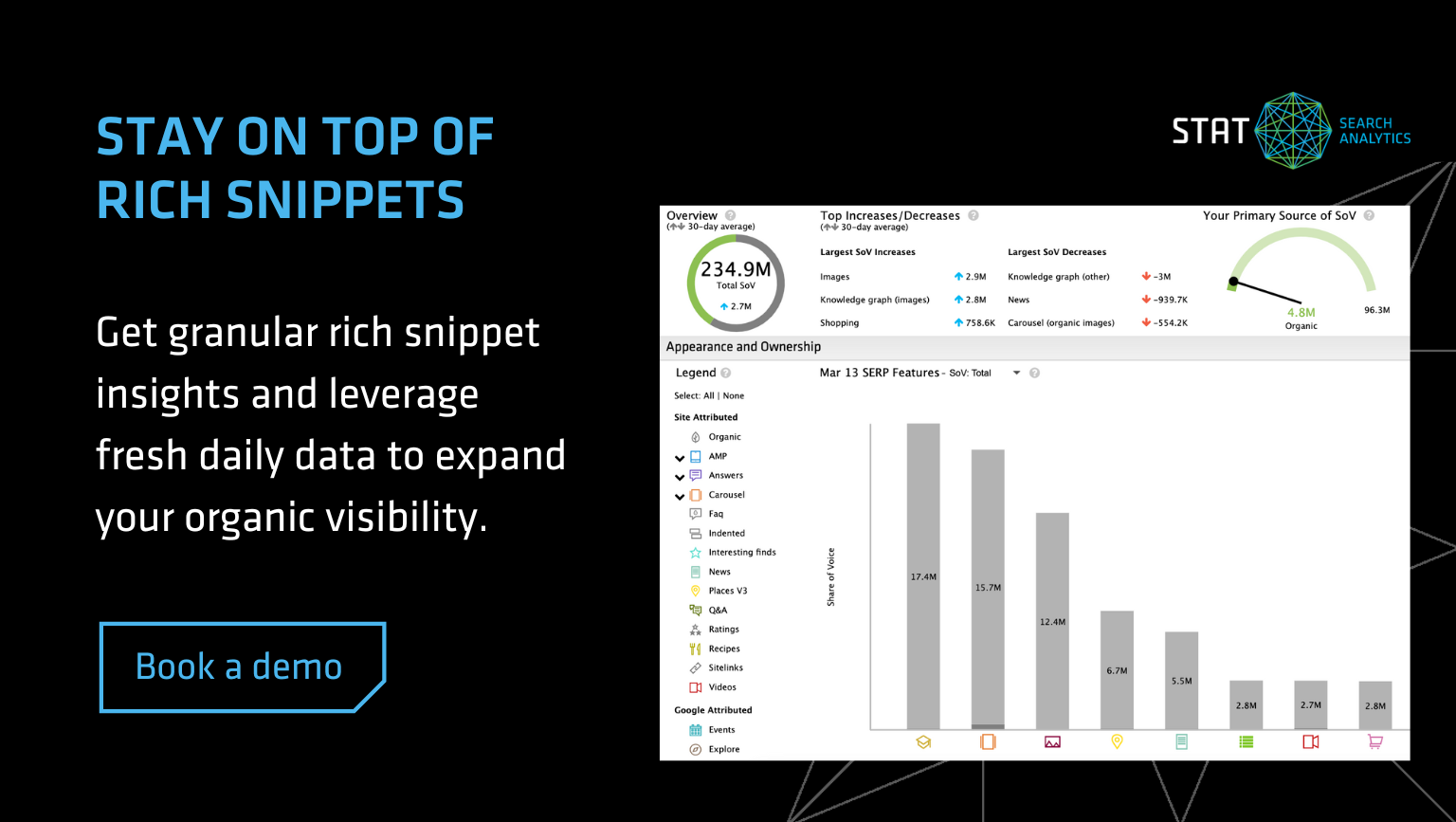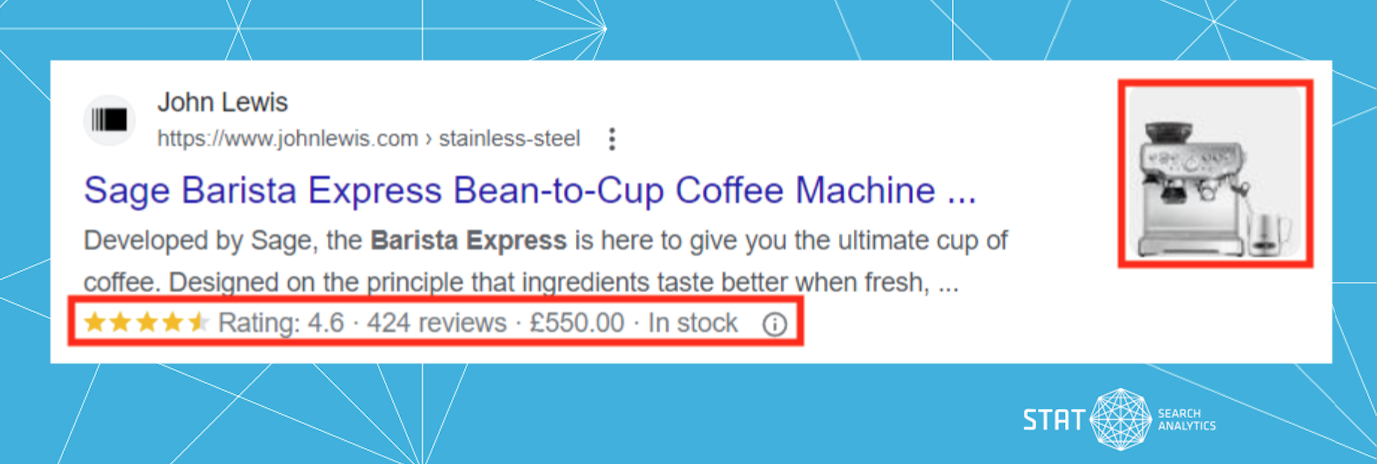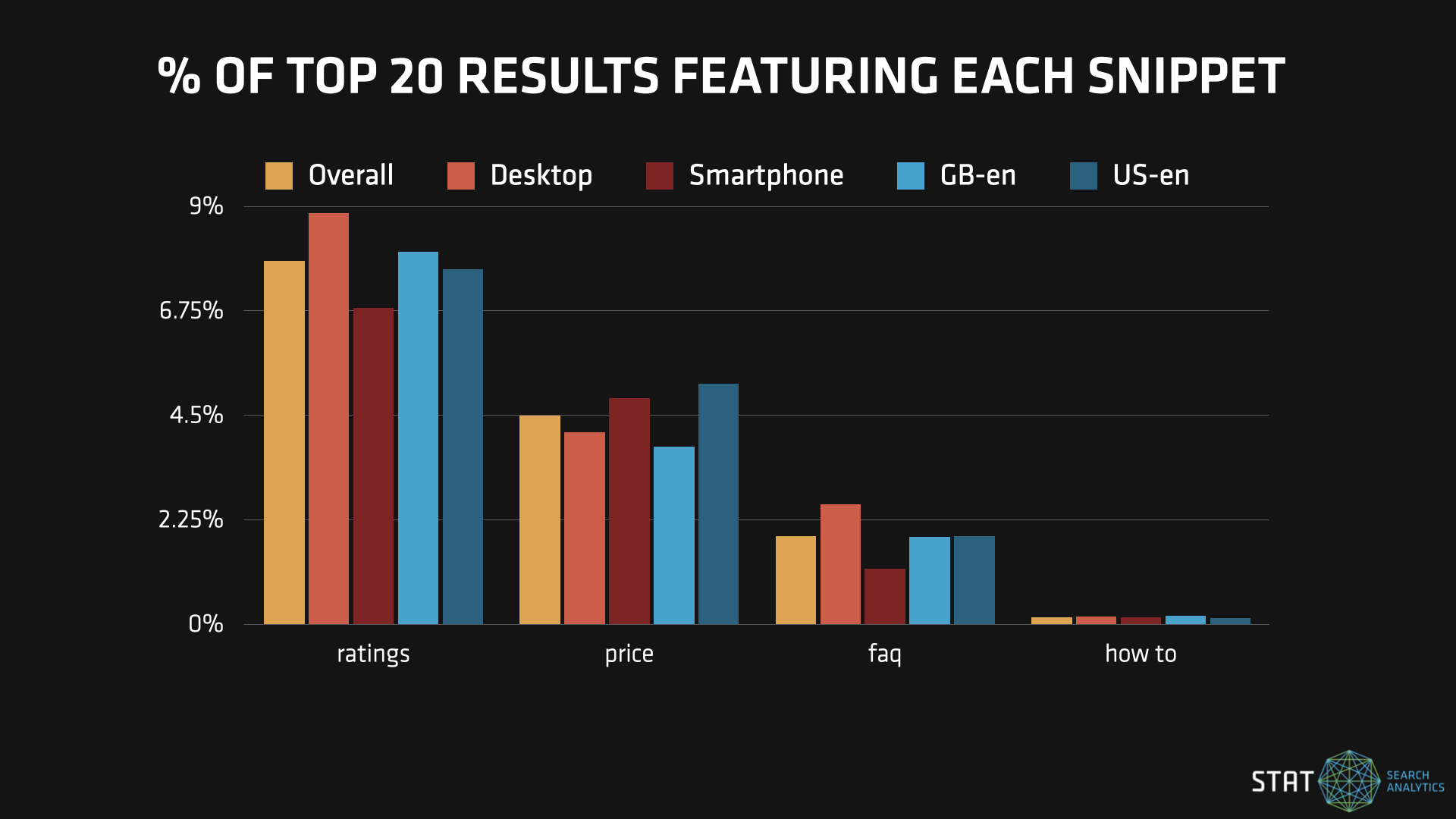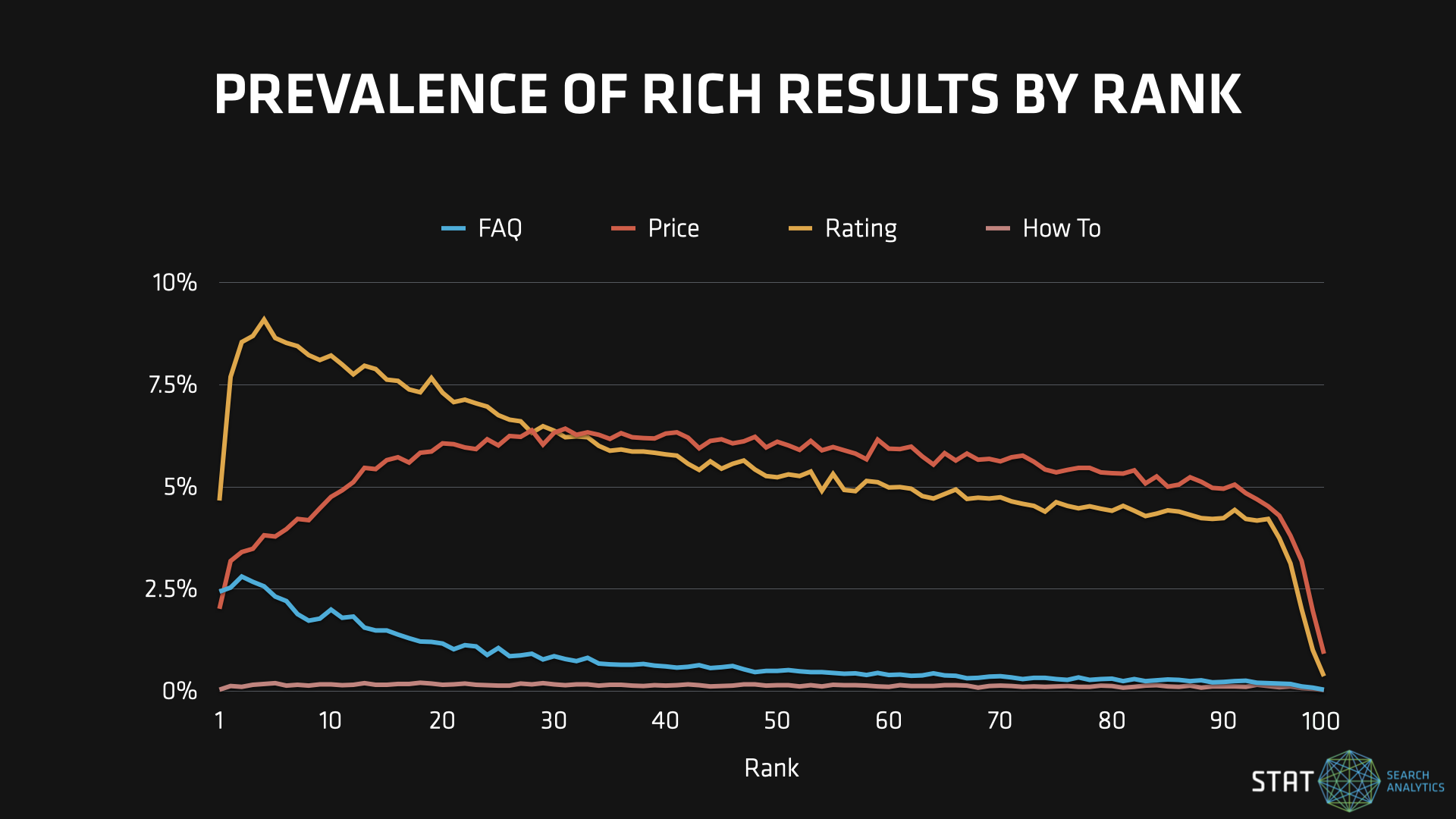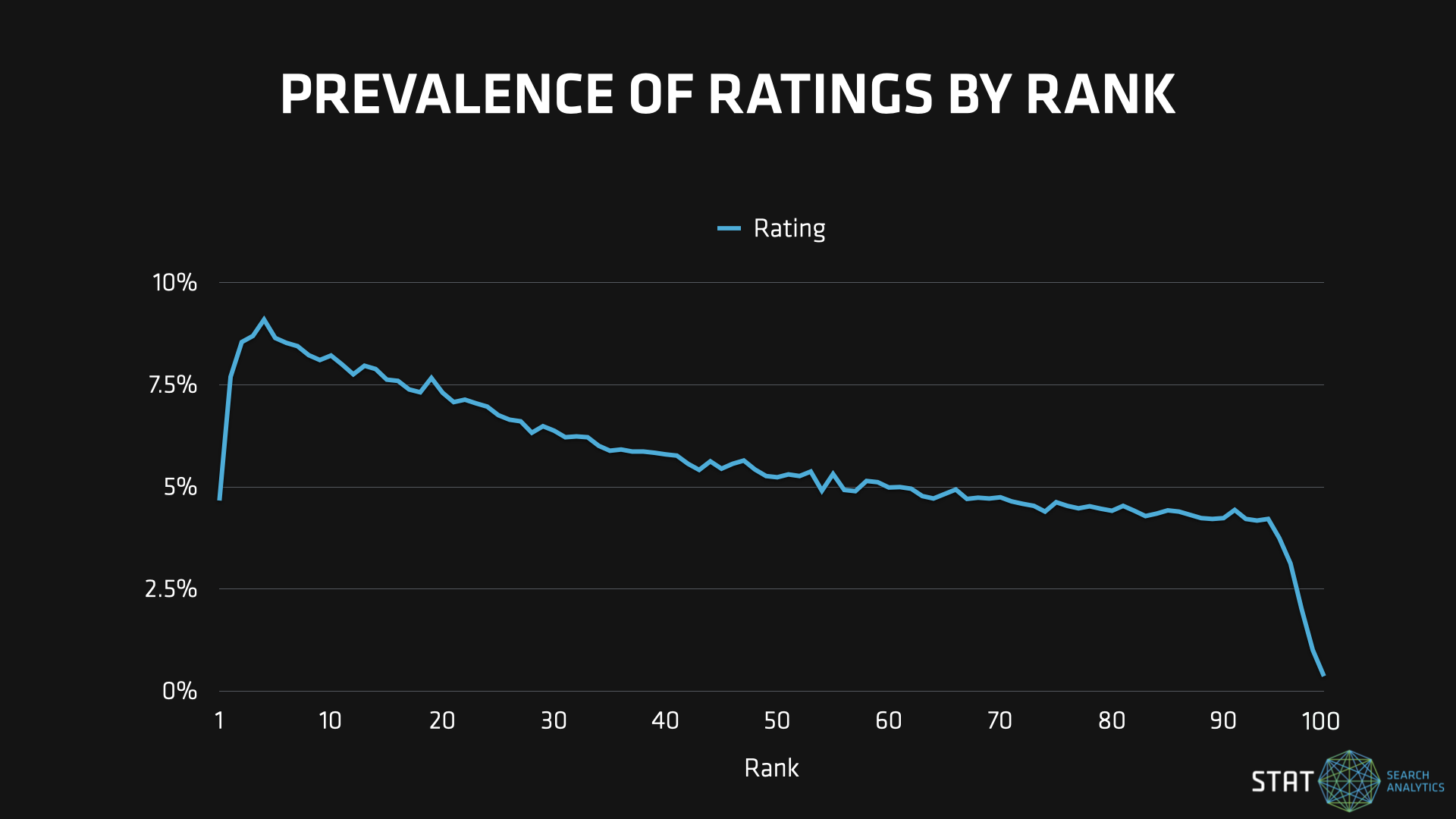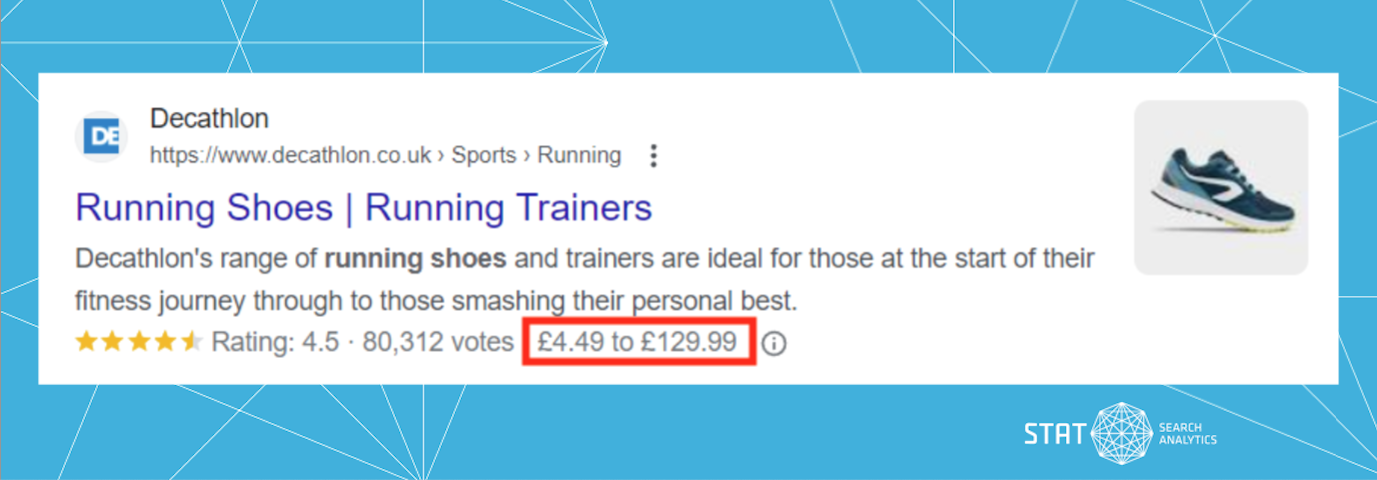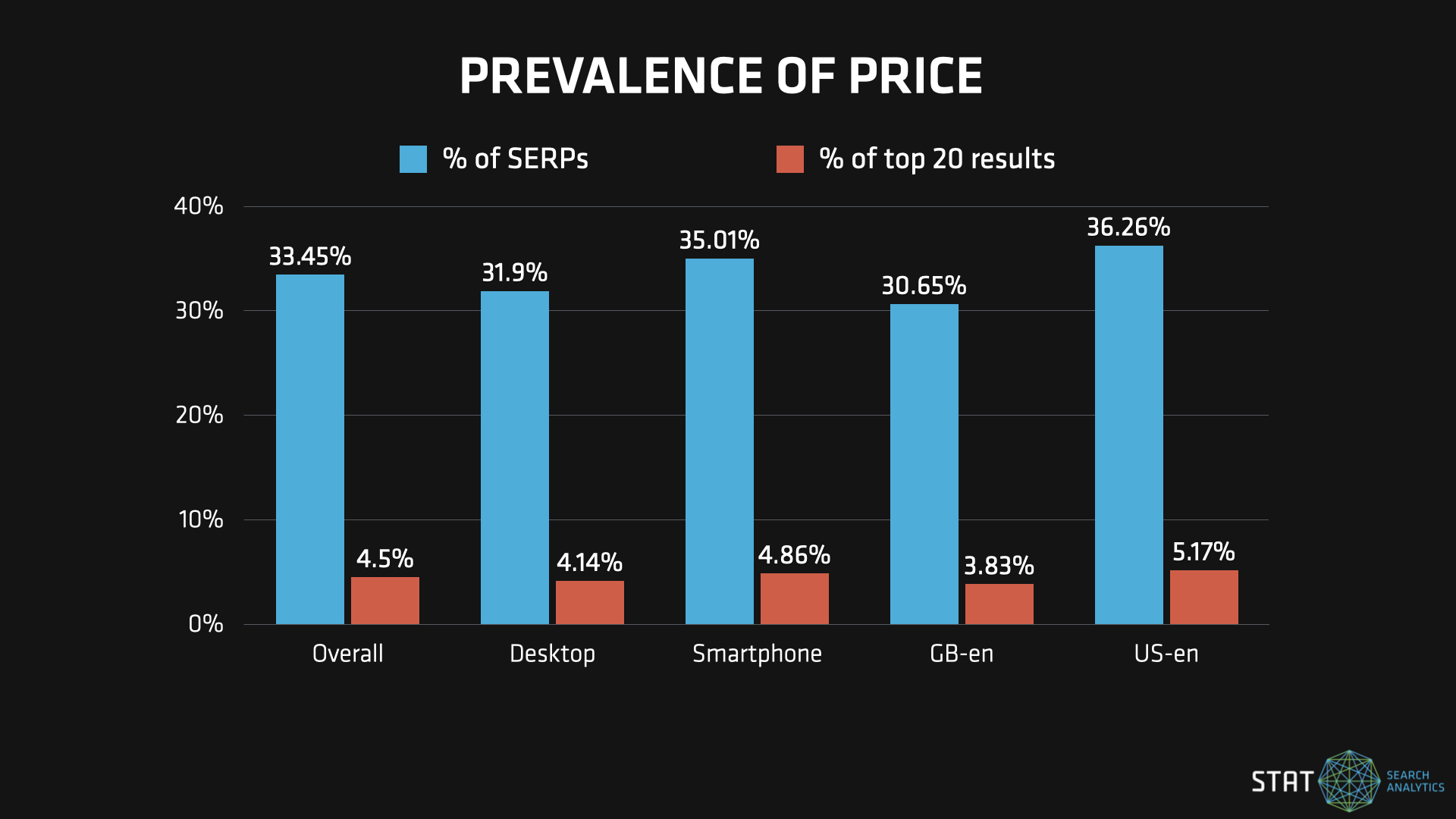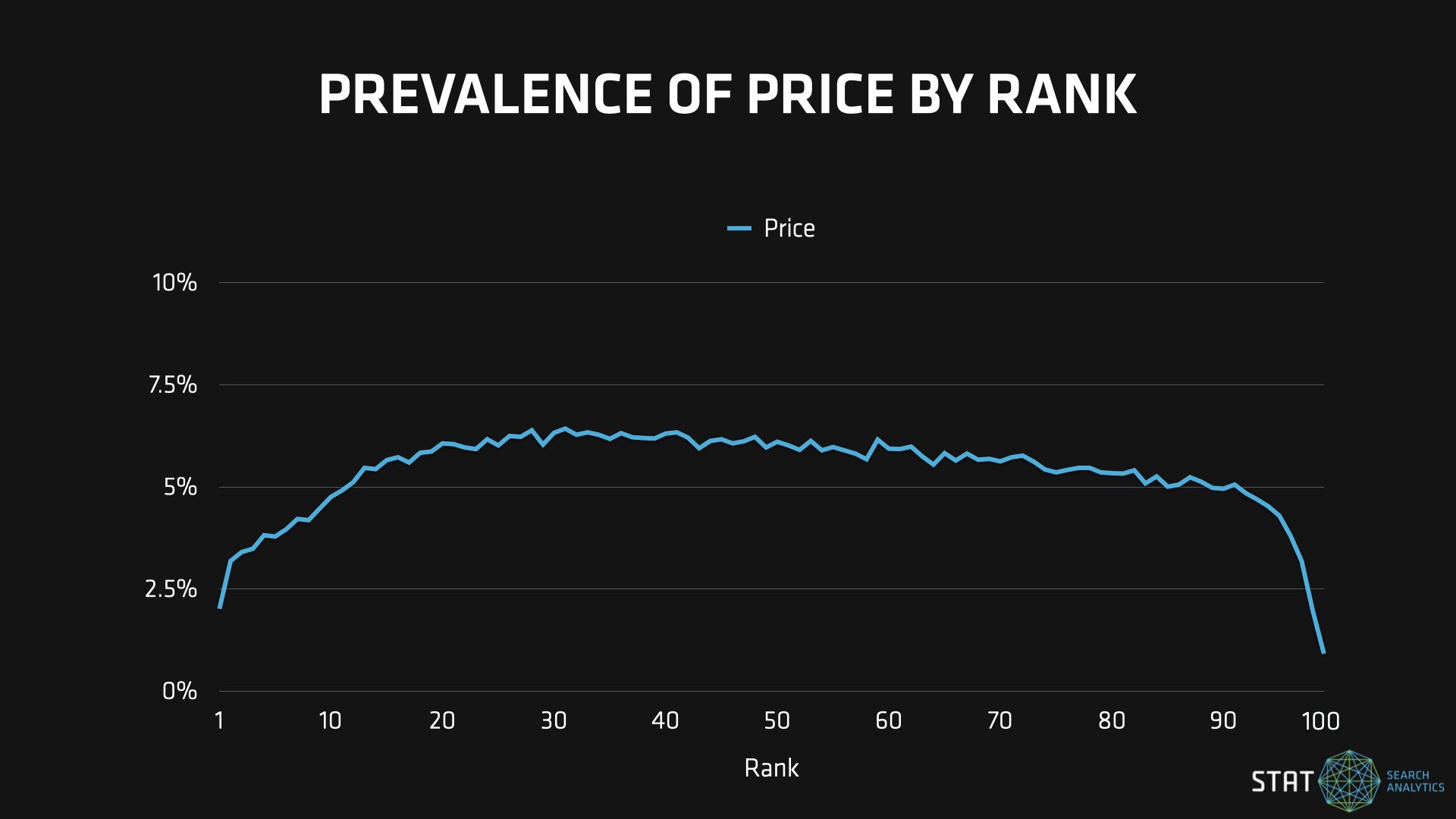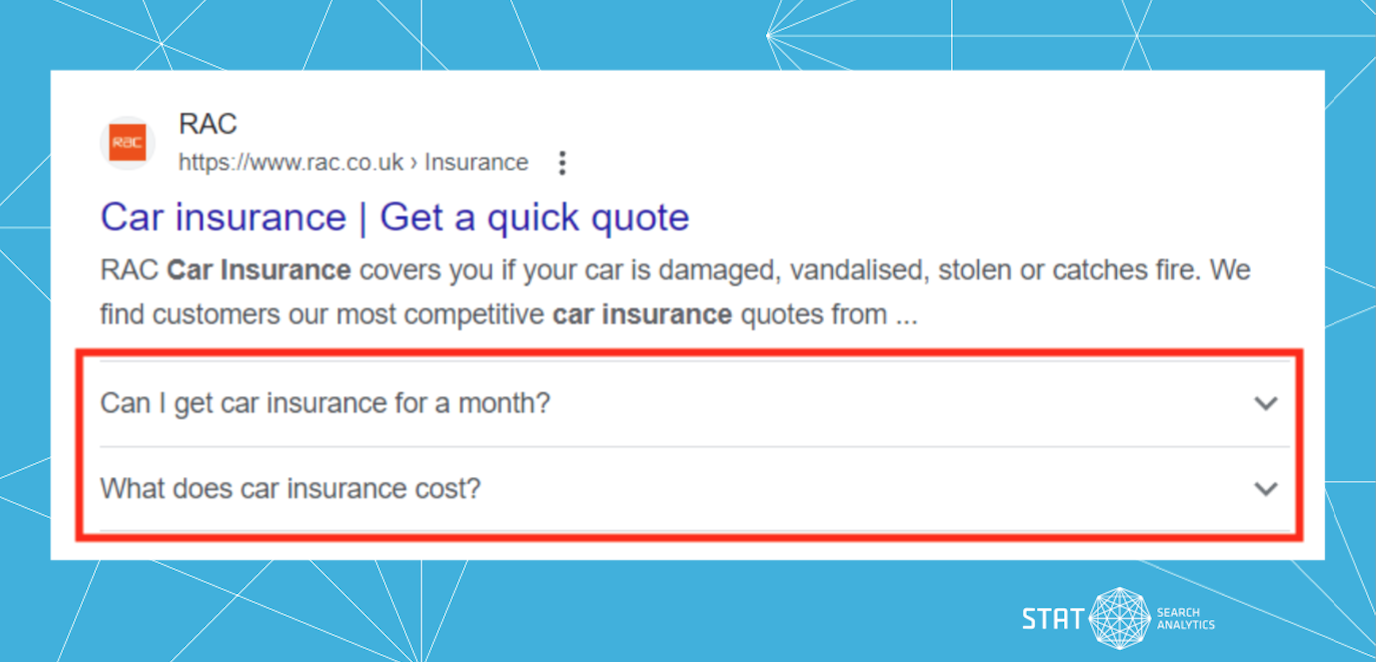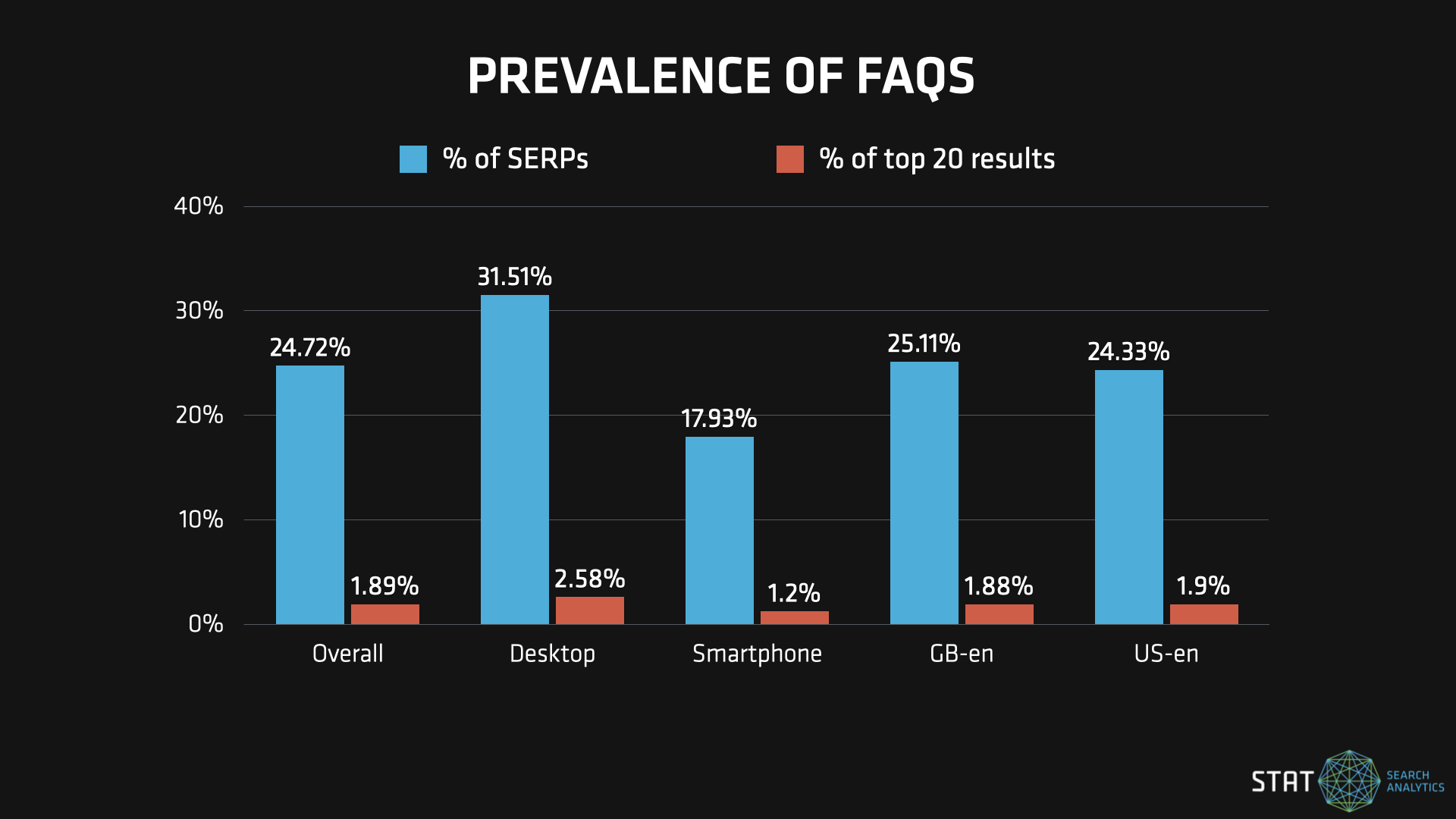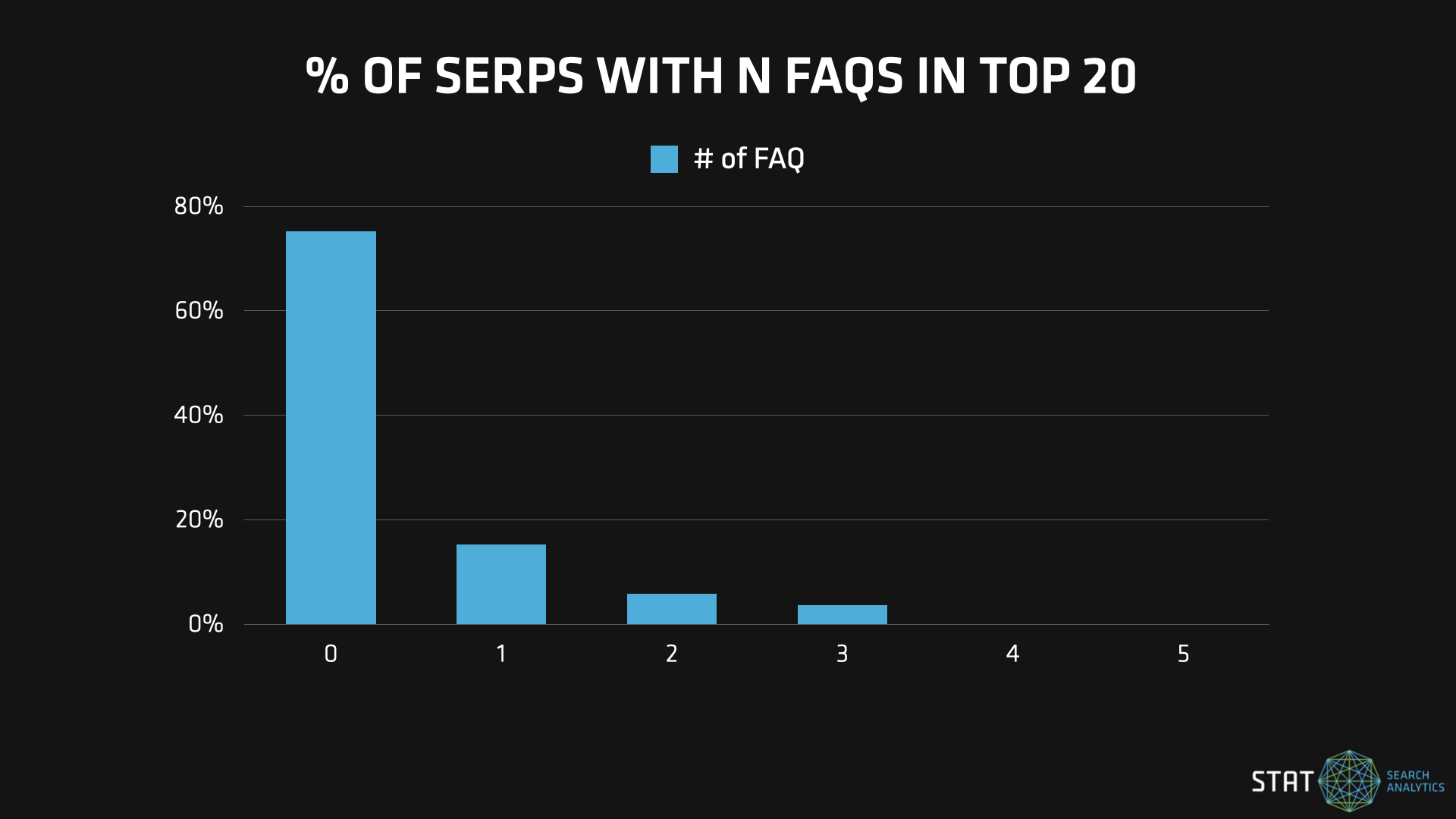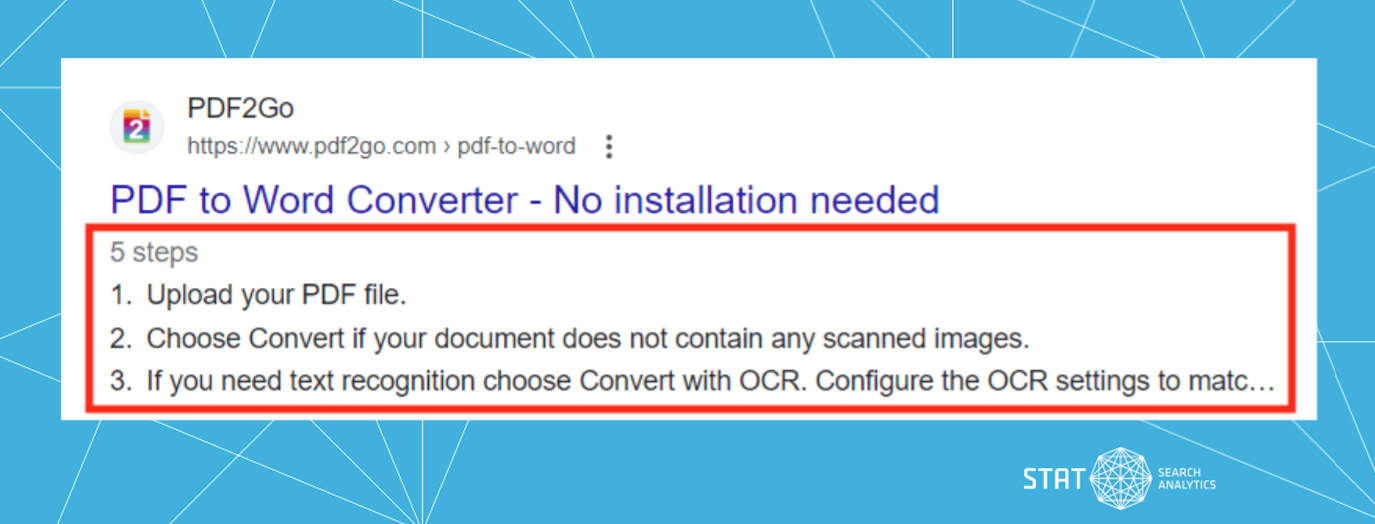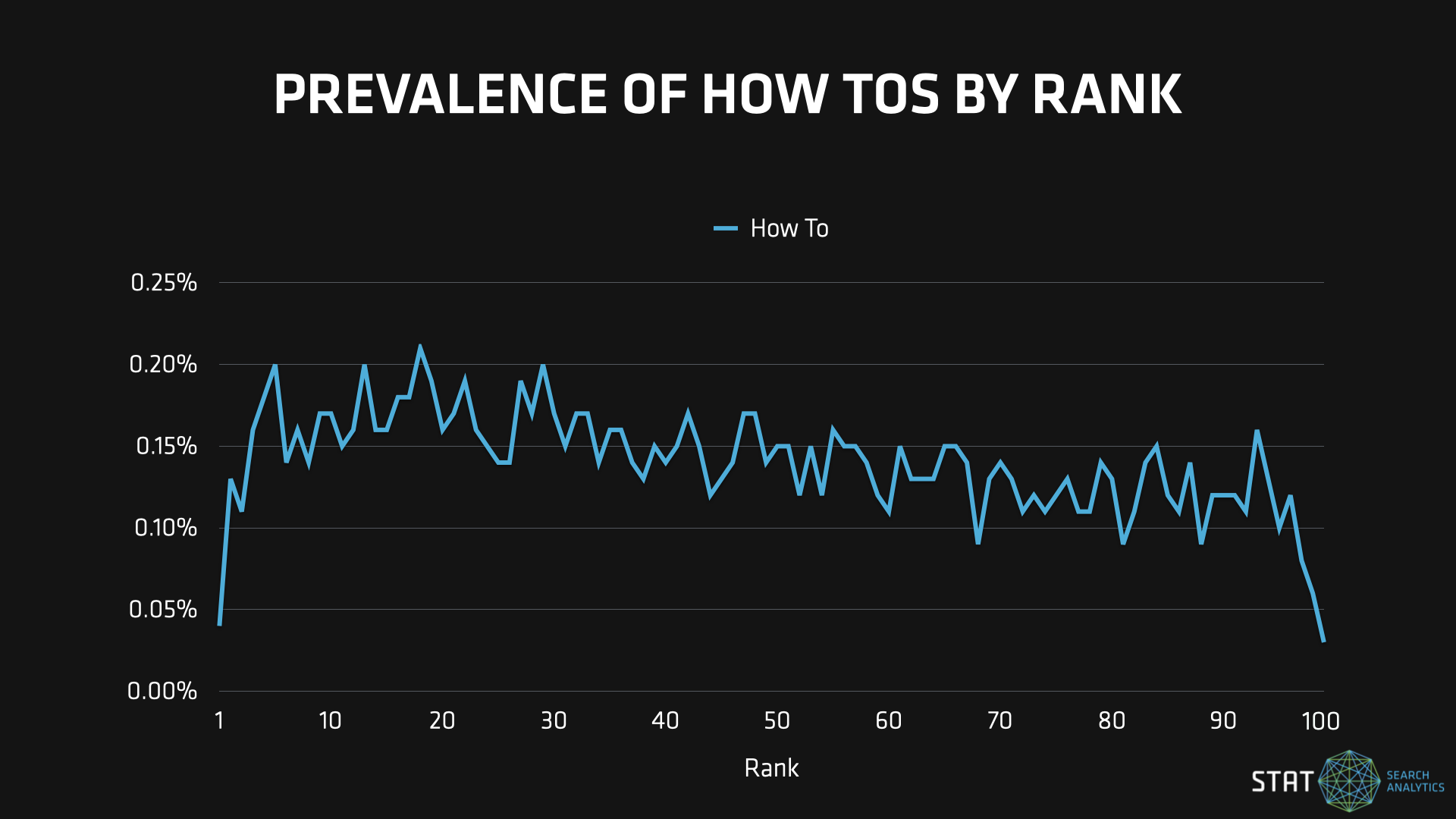We dug into 560,000 SERPs to see which rich results are leading the pack.
When we took a look at the top 5 SERP features driving organic visibility in 2023, local packs came out as the clear winner. For that study, we drew a distinction between SERP features — large, non-traditional modules that are determined and awarded outside of the main search algorithm — and rich snippets (sometimes called rich results), which are simpler augmentations of regular organic results.
Now, its rich snippets’ turn under the microscope.
Rich snippets in the wild
This otherwise plain search result is embellished with ratings, price, and an image.
We’ll cover:
- The methodology of the study
- A high-level analysis of rich snippet prevalence
- A closer look at the prevalence of four rich snippet types:
- Top takeaways
Methodology
Rich results and SERP features do, of course, behave rather differently, so our methodology here is slightly different to that used in our SERP features piece. We’re still using the MozCast corpus of 10,000 head terms, consistently tracked in two suburban locations (one UK, one US), on smartphone and on desktop, giving us a total sample of 40,000 unique SERPs per day. We’re also pulling from the same sample period of February 22nd–March 7th 2023, making for a total of 560,000 SERPs.
One of the ways that rich results are different to SERP features is that SERP features almost always show up on page one, so for fairer comparison we’re focusing on the top 20 ranking positions here (but we’ll also throw in some findings from the top 100 for additional flavour).
Another difference is that as rich results are attached to regular organic results — and thus, inherit their ranking and CTR — analysing them by share of voice doesn’t make as much sense here. Instead, we’re focusing on their prevalence and relationship to rank.
Lastly, as there are far fewer types of rich results than SERP features, we’ve chosen four in particular to focus on: ratings, price, how to, and FAQs.
High-level findings
First we looked at the percentage of SERPs with at least one instance of a rich result in the top 20, and found that the classic flavour of snippet is still the one to beat. 48.11% of all SERPs have at least one ratings result in the top 20.
This is followed by price and FAQ snippets, which have a similar occurrence rate across our SERPs, with How To bringing up the rear.
A high-level look at prevalence
Ratings are clearly leading the pack.
Next we looked at the percentage of all search results in the top 20 that feature a rich snippet as, in many cases, the same rich result will appear several times on the same SERP. So which type is most common overall?
Again, ratings take the gold — 7.83% of all results in the top 20 have a ratings snippet. In fact, its lead in this field is even larger, showing it’s very common to see SERPs with multiple occurrences of ratings. FAQs, on the other hand, drop to a more distant third — one or two per SERP, when they’re present, seems to be the norm. While How Tos barely make a dent here.
Comparisons by market and device
We uncovered some nuanced discrepancies in prevalence by comparing US vs. UK markets and desktop vs. smartphone devices.
Digging a bit more into their multiple occurrences, we didn’t see a single SERP with more than three FAQ results in the top 20. While at the other end of the spectrum, over 400 SERPs had a ratings snippet on every single one of the top 20 regular organic results (e.g. [apple butter recipe], US-en, desktop).
Lastly, we took a one-day snapshot (March 7) and dug into the full 100-result SERPs to see how frequently our rich snippets appeared at each organic ranking position. And what we found was a slightly different relationship with rank across each of our rich snippets.
Prevalence of rich results by rank
It turns out that the correlation with organic rankings differs by snippet type.
Now for the deeper data dive into each rich snippet.
Ratings
Powered by AggregateRating markup, ratings are perhaps the best known rich result type, and with good reason. When rich snippets were first introduced, ratings were one of the original set of supported types, and the first to reach common adoption.
A ratings rich snippet
This rich result provides searchers with a recognizable visual cue that could impact their decision to click.
Still, despite its ubiquity and popularity, there’s reason to be cautious with this snippet type. Google has, in the past, issued Structured Data Penalties to sites that make overly cynical use of this type, perhaps by adding the same rating to every single page of a large site (rather than showing a rating for what’s actually featured on the page).
Ratings in the top 20
A closer look reveals that this rich snippet slightly leans towards desktop results.
Ratings are fairly consistent across device type and geography in our sample, with a slight preference for desktop.
If we look at the full 100 results, we can see that ratings have a reasonably strong relationship with ranking. They seem to prefer the first page, peaking in occurrence at rank five.
Ratings prevalence by rank
A closer look at how frequently rating snippets appeared at each organic ranking position.
We suspect the causation behind this correlation runs both ways and through several channels. For example:
- Generally, better optimized sites will rank better, and are more likely to feature this markup
- Featuring this markup may cause users to seek out your site, which will indirectly benefit your rankings
- Google may not display this markup as willingly if you are not a site it wants to rank well
Price
Price is an interesting rich result type, in that it is not necessarily pulled from structured data. Of course, it can be — product schema can produce results like the one below.
A price rich snippet
A staple for eCommerce sites, price snippets on the SERP can help searchers hone in on results within their budget.
However, you can also see prices pulled in via Offer structured data to show a price that is lower than normal, delivery costs pulled in from product feeds, or “approximate” price ranges simply pulled by Google from the HTML of the page.
The appearance of this rich snippet is relatively consistent across device type and market as well, with a slight leaning towards the US market and smartphone.
Price in the top 20
The price rich snippet is more prevalent in the US and on smartphones.
Unlike ratings, the appearance of price snippets actually peaks quite deep in the SERPs, preferring a page two and three rank. This potentially indicates that branded pages and review sites can sometimes dominate further up, as they’re less likely to contain pricing markup.
Prevalence of price rich results by rank
When compared to ratings and FAQs, price prevalence tends to peak much further down the SERP around rank 30.
FAQs
When they first appeared on the scene, many SEOs did not think FAQs would last. They felt just a bit too good to be true, seeming easy to surface and high impact for relatively low effort. But, here they are, years later, still going strong.
An FAQ rich snippet
FAQs allow you to provide questions and answers for searchers right on the SERP.
This result type is pulled from fairly rigid schema: a combination of FAQPage, Question, and Answer. Of course, as with any rich result, the presence of valid schema on your site provides no guarantee of the enhanced result appearing in SERPs.
FAQs proved to have the most dramatic contrast by device of the bunch — 31.51% of desktop top SERPs feature an FAQ, which is almost double the equivalent stat on smartphone SERPs. This could be because, when expanded, FAQs take up more SERP real estate, so the bigger desktop screen gives them plenty of wiggle room.
FAQs in the top 20
The stark contrast between FAQ prevalence on desktop vs. smartphone is undeniable.
Like ratings, FAQ rich snippets were much more prevalent at the top of the SERP, peaking even earlier at rank three, and dropping fairly steadily in frequency the further down the SERP you travel.
FAQ rich snippet prevalence by rank
We saw a strong correlation between rankings and the prevalence of FAQ rich results.
The strong bias towards higher ranking positions may be related to Google’s seeming reluctance to show a high number of FAQs on a given SERP — we found no more than three FAQs appearing in the top 20 at any given time. This hard stop is unlike ratings and prices, which can become almost ubiquitous in some verticals.
Frequency of FAQ occurrences on the same SERP
It turns out that (more than) three is a crowd when it comes to FAQs in the top 20 on the same SERP.
How To
How To is another result type with fairly rigid structured data requirements, leaning on the HowTo schema.org type.
A How To rich snippet
Step-by-step instructions can be laid out for searchers in this rich result type.
Compared to the ratings, price, and FAQ rich result types above, though, we’re seeing a sharp drop off here into far more obscure territory. This is consistent by device and geography — prevalence is consistently low.
How Tos in the top 20
How Tos proved far less prevalent across the board than ratings, price, and FAQs.
There’s also, at most, a weak relationship with rank. The How To rich snippet doesn’t seem to favour any ranking position in particular, appearing mostly evenly across the top 100 results.
How To rich snippet prevalence by rank
We didn’t see the same correlation between rank and How Tos as our previous result types.
We also didn’t see any SERPs with more than three How To rich results in the top 20, but that’s perhaps not surprising given the overall rarity.
Top takeaways: The big two
Really, we should be saying the big three, right? Ratings, price, and FAQ were all pretty prevalent.
The trouble with price, though, is that it aggregates a bunch of different implementations that might be used, it’s not as eye-catching in the SERP as ratings or FAQ, and it only applies to certain kinds of pages (mainly within eCommerce, and, to a degree, travel).
Ratings and FAQ, on the other hand, can be employed in virtually any vertical, and also happen to get a lot of their exposure from high ranking results. As we discussed above, one could argue about the causality there, but, either way, these are the results that you are typically going to want to focus on and care about.
Plus, as a bonus, FAQs especially are very easy to implement, and ratings too as long as you have some sort of filterable review database (which chances are, you do).
Ready to work rich snippets into your SEO strategy?
Now that we’ve taken a closer look at rich snippets, you may be thinking about the potential impact of optimizing to snag some for yourself. If you’re curious about how to ensure your pages are eligible to surface rich results, we ran through how to optimize and shared examples of the structured data you’ll want to add to your site.
If you’re wondering about the prevalence of rich results in your own keyword set, our SERP Features tab can give you the nitty gritty details of the snippets being surfaced and how many you already own. And if all of this rich snippet data has piqued your interest and you’d like to see STAT in action, drop us a line — we’d be happy to give you a guided tour.
